Verdict
Horizon Call of the Mountain is a must-buy purchase for any PlayStation VR 2 owners, with a full-length adventure featuring thrilling climbing mechanics and engaging combat. And best of all, the interactive world looks absolutely incredible in 4K thanks to the power of the PS5 console.
Pros
- Interactive world is wonderfully immersive
- Cimbing in VR feels fantastic
- Fun combat with bow and arrow
- Jaw-dropping visuals and environments
Cons
- Story is forgettable
- Puzzles aren’t very challenging
Availability
- UKRRP: £59.99
- USARRP: $59.99
-
Platforms:PlayStation VR 2 -
Release date:22nd February 2023 -
Genre:Action-adventure
Introduction
Horizon Call of the Mountain is one of the very first games to launch on PlayStation VR 2, and is arguably the crown jewel of the virtual reality headset.
Sony is pitching this Horizon spin-off as the PSVR 2’s system seller, in a similar fashion to how Breath of the Wild launched with the Nintendo Switch, and Halo helped thrust the Xbox into the spotlight.
That’s a lot of pressure to stack on one game, but yet Guerrilla Games and Firesprite have delivered. This is one of the best VR games I’ve played yet, with a full-length adventure featuring exhilarating climbing and tense combat. If you’re planning on buying a PlayStation VR 2 headset, this is a must-buy purchase.
Interactive world
- The world looks amazing, and is incredibly immersive
- Robot monsters look more imposing in VR
- Can pick up virtually any object you see
I’ll never forget the first time I entered the world of Horizon Call of the Mountain. Snaking through the jungle on a wooden boat, you’re treated to stunning visuals of various robotic monsters. The crocodile-like Snapjaws lurk in the river, while the towering Tallneck shakes the ground as it steps over your boat.
I’ve become well accustomed to these mechanical monsters from Horizon Forbidden West and Horizon Zero Dawn, but I’ve never appreciated their colossal scale until donning the VR headset. This makes these monsters all the more terrifying, while also allowing me to observe the incredible level of detail that has gone into their designs and animations.
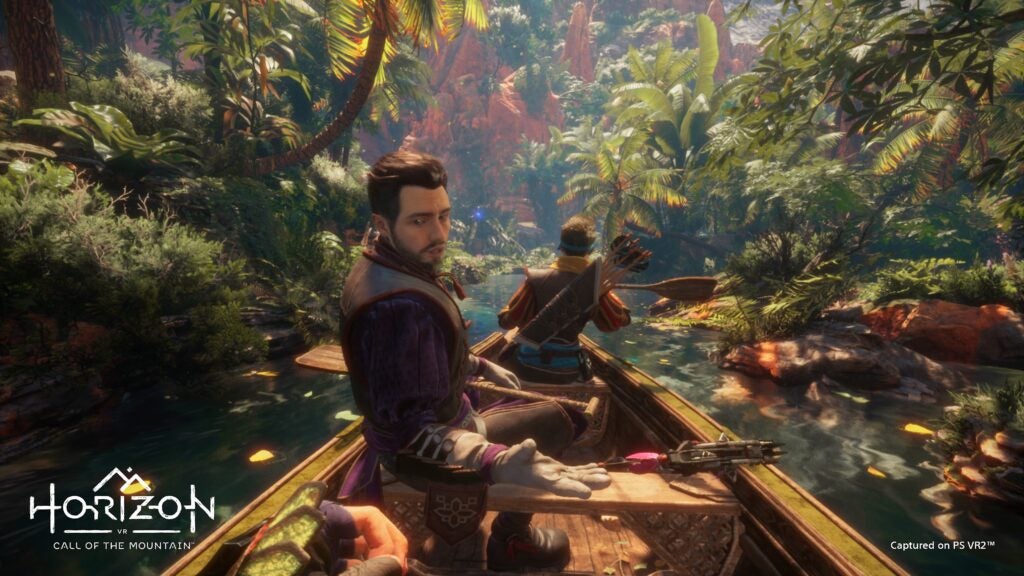
The environments of Horizon Call of the Mountain are jaw-droppingly beautiful. VR games rarely offer this level of realism, with a staggering amount of detail, from the moss-covered rocks to the mountainscape in the background.
If this was just a non-interactive demo to show the level of immersion that PSVR 2 games can achieve, then I’d still be very impressed. And yet once your boat capsizes and you’re able to explore the world on foot, Call of the Mountain finds new ways to impress.
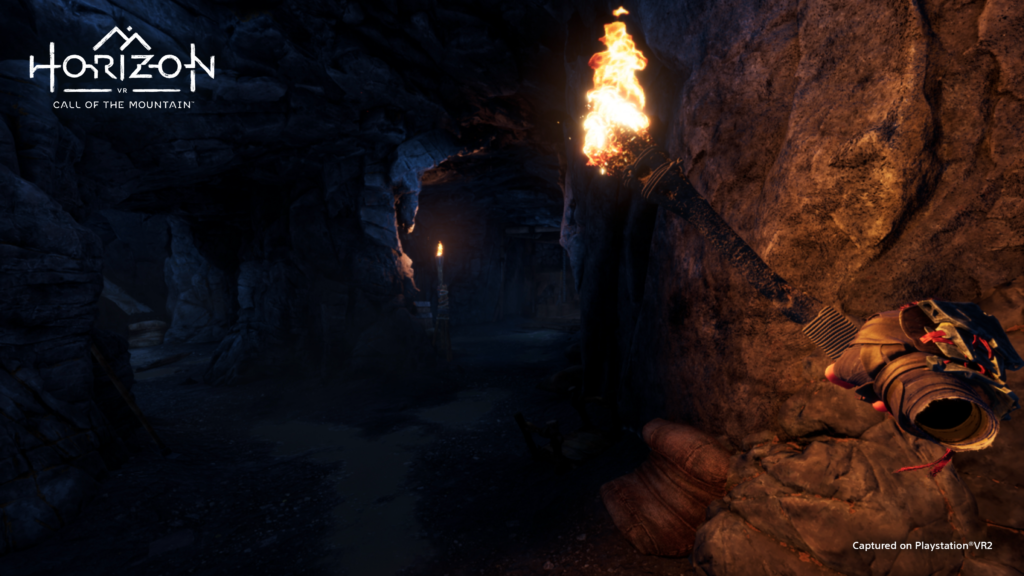
You’re able to interact with almost every object you see. You can pick up mugs and hurl them into a wall, or even start drumming on abandoned musical instruments. And instead of simply pressing a button to pluck arrows from your quiver, you simply reach behind your shoulder and press down on the controller’s trigger – it feels so natural, and incredibly satisfying.
There are lots and lots of other mechanics that feel great to use in VR. You can restore health by munching on an apple, unlock doors by physically twisting a key inside a lock and clamber up walls by swinging your arms up into the air.
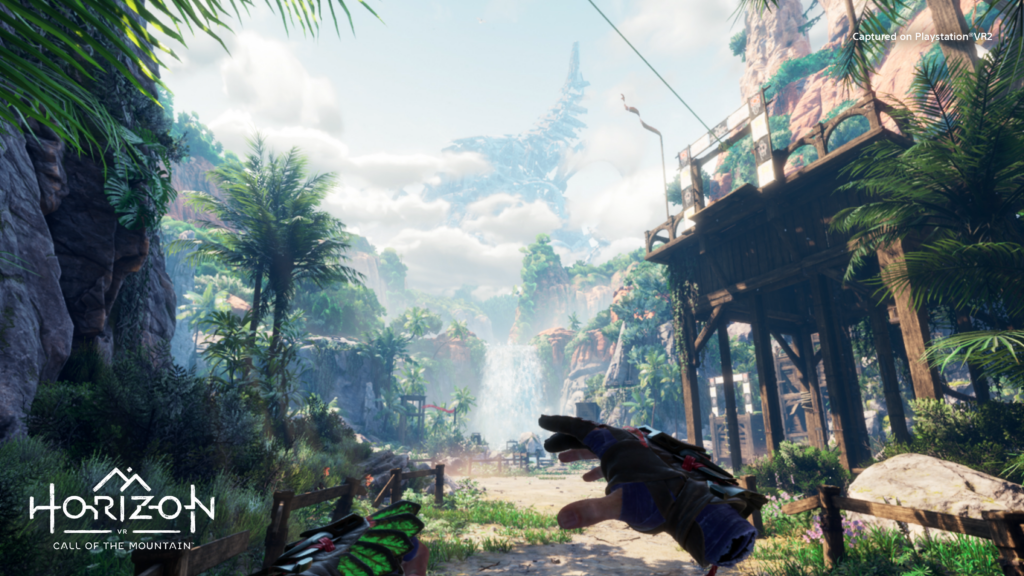
By default, you’ll even move your character forwards by moving your arms up and down. This initially felt a little odd, but I soon warmed to the mechanic – you’ve always the option to switch to using the analogue sticks if you prefer.
Combat
- The bow is a joy to use
- Monsters have unique attacks and behaviour
- Can only dodge side to side during combat
The bow is a joy to use in Horizon Call of the Mountain. As you’d expect, you need to physically place an arrow into your bowstring and then pull back in order to shoot. It took time for me to get used to this mechanic and practise my shot, but I soon developed the confidence of Katniss Everdeen.
The adaptive triggers of the PSVR Sense controllers will vibrate to mimic the tension of a bowstring when pulled back. It’s subtle elements such as this that help fool you into thinking you’re actually holding a bow and arrow, when you’re really just looking like a prat in your living room.
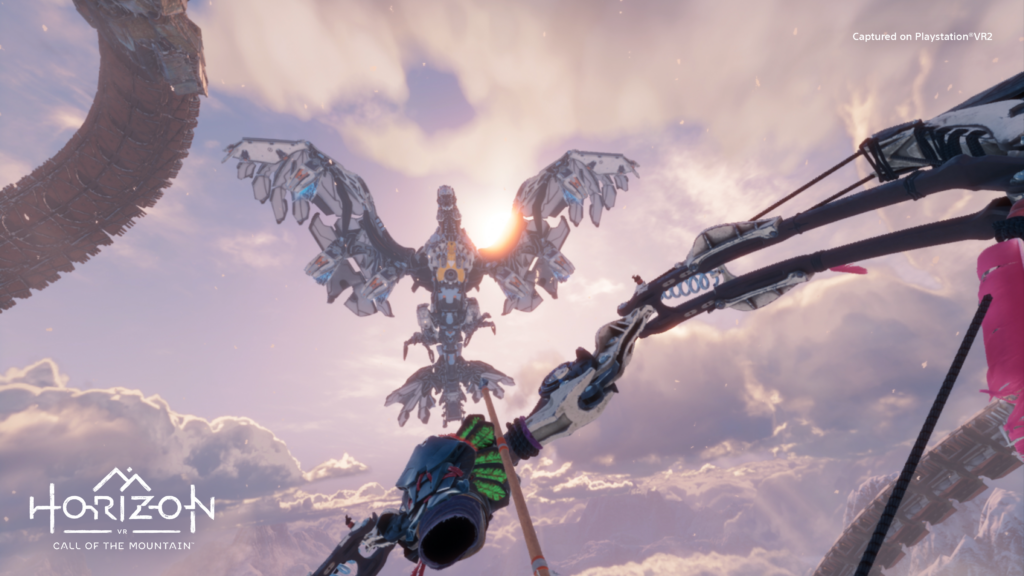
To accommodate the VR format, combat has been scaled down compared to other Horizon games. You’re limited to bows and bombs, so you’re not able to stealthily plant traps and the like. But you can still knock armour and weapons off machines with well-placed shots, and monsters have a stunning variety of attacks from flamethrowers to homing missiles.
Every monster felt satisfyingly unique, with the Shell-Walkers using a defensive shield to block arrows hitting its front, while Scrappers will dart around the environment before leaping towards you. The giant Thunderjaw makes a return too, with a huge arsenal of weapons – taking it down in VR feels so rewarding, especially since it looks like the size of a mountain through a first-person perspective.
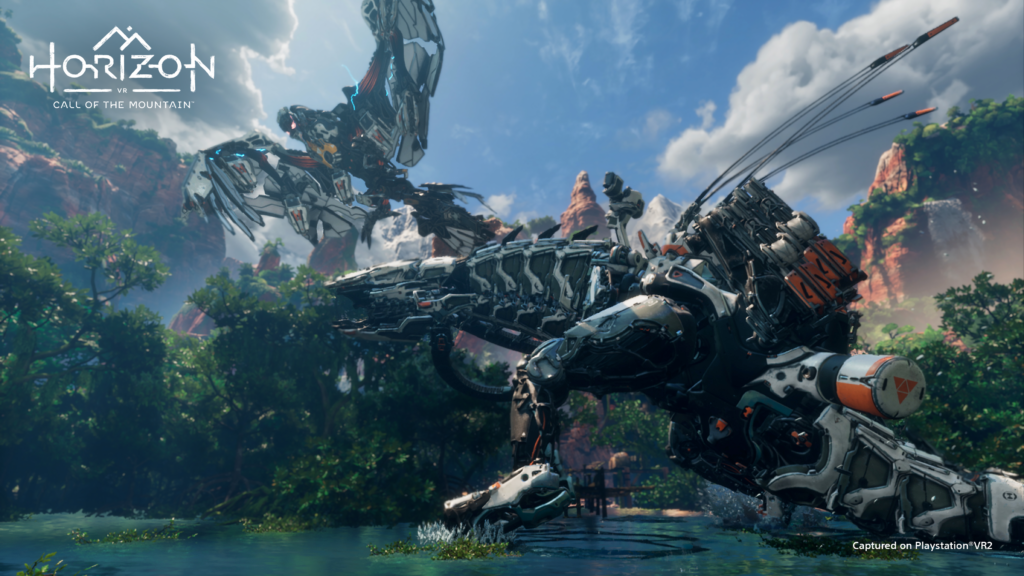
Your movement is restricted to sideway dodges during combat rather than the standard 360-degree freedom of the mainline games. But I really don’t think that’s a problem; the fun of physically aiming your bow largely makes up for that, while seeing a mammoth monster charging at you in VR is absolutely thrilling.
You’ll unlock new arrow types as you progress through the story. Crafting new arrows involves you manually sticking the parts together to create a more authentic experience, although you can fortunately craft in bulk, so you won’t need to repeat the process multiple times in order to stock up.
Climbing
- Climbing feels really fun in VR
- Slowly unlock more climbing gear
- Puzzles aren’t very challenging
As fun as the combat is, it’s actually the climbing segments that steal the show. To start, you’re only able to grab cliff edges and slowly clamber up the side of a wall. But this is still far more engaging in VR compared to classic controllers, with the physical exertion required making you feel like you really are climbing up a wall – my smartwatch even congratulated me for several workouts.
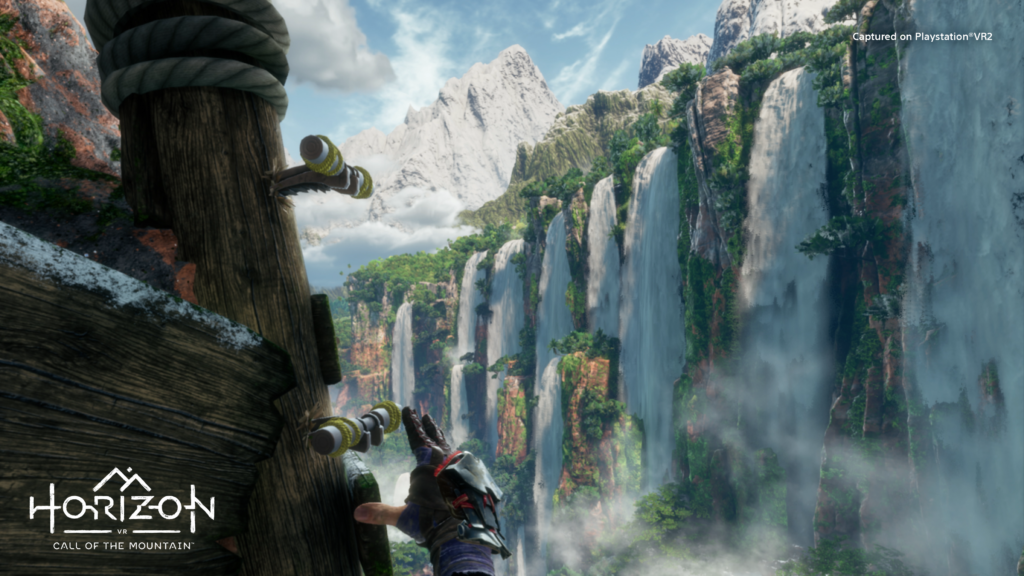
Horizon Call of the Mountain makes sure to keep the climbing mechanics engaging by drip feeding you with new tools throughout the adventure. I personally loved the pickaxes that see you smash the metal blade into the rock to get a secure hold and then scurry up the side of the mountain.
The ropecaster is another one of my favourites, allowing me to swing across ravines for adrenaline-inducing stunts. I never got bored of leaping off a cliff in this game, proving far more exciting than even the stunts in Uncharted, purely down to the extra immersion provided by VR.
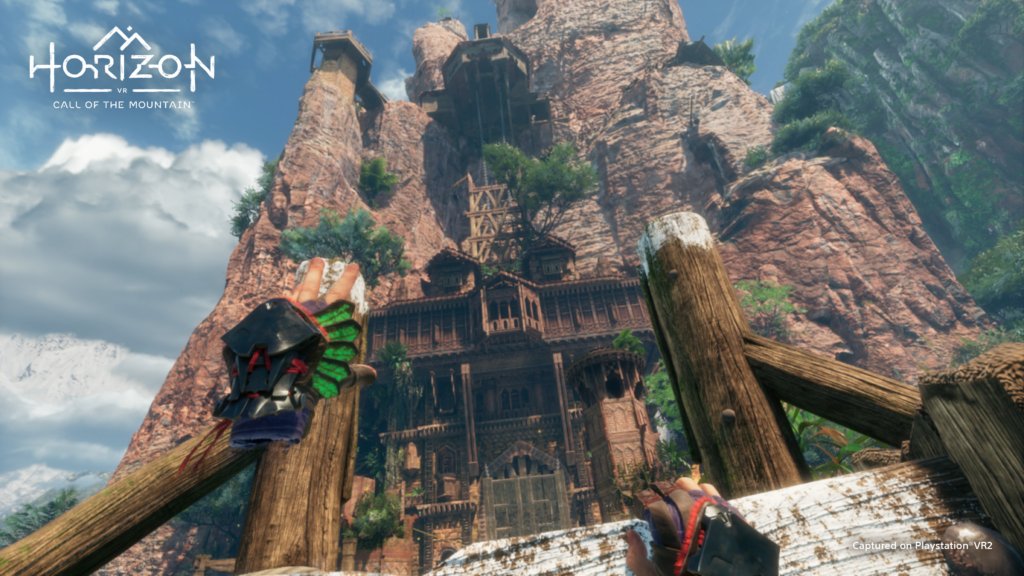
When unlocking a new tool, you’ll be required to create them yourself. This involves physically binding the parts together with string, once again taking full advantage of the PSVR 2 platform.
Since climbing a mountain is tiring work, there are fortunately a few puzzle segments added into the campaign to vary up the gameplay. These puzzles are fine for the most part, but I do wish they were a little bit more challenging, rather than finding a cog and slotting it into place.
Story
- Perspective of a new character
- Story is largely forgettable
- Cameos from the likes of Aloy
The story in Call of the Mountain is viewed from the perspective of a new character called Ryas. As a former Shadow Carja, he is looking to redeem himself by finding his brother, who has gone missing after a perilous expedition up the mountain.
The story is pretty basic, and is unlikely to leave a lasting impression, but it at least provides a welcome breather in between levels. That said, I do think it harms the momentum of your adventure, especially since the vast majority of dialogue sequences take place in the same town.
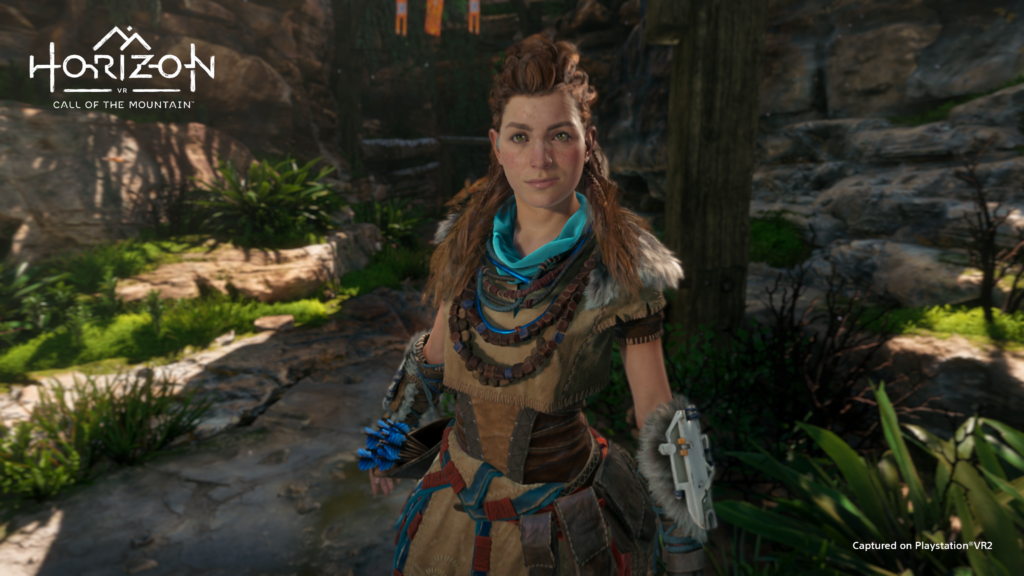
You’ll be up in the snowy mountains during your ascent, only to then return right at the starting point just so you can update the other characters about your progress – it feels very silly. It would have made more sense for you to have a companion during your adventure, in a similar vein to Ellie from The Last of Us or Sully from Uncharted.
Dialogue is well written though, and there are a couple of recognisable faces, such as Aloy, to provide a welcome dose of fan service. But I was personally more impressed by the characters’ models than what they had to say, with the VR perspective also allowing for a more engaging face-to-face conversation.
Latest deals
Should you buy it?
If you own a PlayStation VR 2 headset:
This is the best game on the PlayStation VR 2 yet, and is a must-buy purchase if you do decide to get the new headset.
You’re looking for a similar experience to Horizon Forbidden West:
Horizon Call of the Mountain may be from the same universe as its PS5 counterpart, but they are very different games. While Forbidden West is an open-world RPG, Call of the Mountain is a linear adventure that puts more emphasis on climbing and combat than exploration.
Final Thoughts
Horizon Call of the Mountain has set a new benchmark for VR games. Rather than trying to shoehorn classic game mechanics into the VR format, Guerrilla Games and Firesprite have rebuilt the likes of combat and climbing from scratch to result in a wonderfully immersive experience. This is one of the absolute best VR games I’ve ever played, and is a must-have purchase for anyone who buys a PlayStation VR 2 headset.
How we test
We play every game we review through to the end, outside of certain exceptions where getting 100% completion, like Skyrim, is close to impossible to do. When we don’t fully finish a game before reviewing it we will always alert the reader.
Tested on PlayStation VR 2
Played through 8-hour story campaign
FAQs
Yes, Horizon Call of the Mountain is a full single-player game, and takes around 8 hours to complete the campaign.
Horizon Call of the Mountain is more of a spin-off, set in the same universe as previous games (featuring cameos from familiar characters) but with an all-new story separate to Aloy’s.
Yes, Horizon Call of the Mountain is only playable in VR via the PlayStation VR 2 headset.
Verdict
Horizon Call of the Mountain is a must-buy purchase for any PlayStation VR 2 owners, with a full-length adventure featuring thrilling climbing mechanics and engaging combat. And best of all, the interactive world looks absolutely incredible in 4K thanks to the power of the PS5 console.
Pros
- Interactive world is wonderfully immersive
- Cimbing in VR feels fantastic
- Fun combat with bow and arrow
- Jaw-dropping visuals and environments
Cons
- Story is forgettable
- Puzzles aren’t very challenging
Availability
- UKRRP: £59.99
- USARRP: $59.99
-
Platforms:PlayStation VR 2 -
Release date:22nd February 2023 -
Genre:Action-adventure
Introduction
Horizon Call of the Mountain is one of the very first games to launch on PlayStation VR 2, and is arguably the crown jewel of the virtual reality headset.
Sony is pitching this Horizon spin-off as the PSVR 2’s system seller, in a similar fashion to how Breath of the Wild launched with the Nintendo Switch, and Halo helped thrust the Xbox into the spotlight.
That’s a lot of pressure to stack on one game, but yet Guerrilla Games and Firesprite have delivered. This is one of the best VR games I’ve played yet, with a full-length adventure featuring exhilarating climbing and tense combat. If you’re planning on buying a PlayStation VR 2 headset, this is a must-buy purchase.
Interactive world
- The world looks amazing, and is incredibly immersive
- Robot monsters look more imposing in VR
- Can pick up virtually any object you see
I’ll never forget the first time I entered the world of Horizon Call of the Mountain. Snaking through the jungle on a wooden boat, you’re treated to stunning visuals of various robotic monsters. The crocodile-like Snapjaws lurk in the river, while the towering Tallneck shakes the ground as it steps over your boat.
I’ve become well accustomed to these mechanical monsters from Horizon Forbidden West and Horizon Zero Dawn, but I’ve never appreciated their colossal scale until donning the VR headset. This makes these monsters all the more terrifying, while also allowing me to observe the incredible level of detail that has gone into their designs and animations.

The environments of Horizon Call of the Mountain are jaw-droppingly beautiful. VR games rarely offer this level of realism, with a staggering amount of detail, from the moss-covered rocks to the mountainscape in the background.
If this was just a non-interactive demo to show the level of immersion that PSVR 2 games can achieve, then I’d still be very impressed. And yet once your boat capsizes and you’re able to explore the world on foot, Call of the Mountain finds new ways to impress.

You’re able to interact with almost every object you see. You can pick up mugs and hurl them into a wall, or even start drumming on abandoned musical instruments. And instead of simply pressing a button to pluck arrows from your quiver, you simply reach behind your shoulder and press down on the controller’s trigger – it feels so natural, and incredibly satisfying.
There are lots and lots of other mechanics that feel great to use in VR. You can restore health by munching on an apple, unlock doors by physically twisting a key inside a lock and clamber up walls by swinging your arms up into the air.

By default, you’ll even move your character forwards by moving your arms up and down. This initially felt a little odd, but I soon warmed to the mechanic – you’ve always the option to switch to using the analogue sticks if you prefer.
Combat
- The bow is a joy to use
- Monsters have unique attacks and behaviour
- Can only dodge side to side during combat
The bow is a joy to use in Horizon Call of the Mountain. As you’d expect, you need to physically place an arrow into your bowstring and then pull back in order to shoot. It took time for me to get used to this mechanic and practise my shot, but I soon developed the confidence of Katniss Everdeen.
The adaptive triggers of the PSVR Sense controllers will vibrate to mimic the tension of a bowstring when pulled back. It’s subtle elements such as this that help fool you into thinking you’re actually holding a bow and arrow, when you’re really just looking like a prat in your living room.

To accommodate the VR format, combat has been scaled down compared to other Horizon games. You’re limited to bows and bombs, so you’re not able to stealthily plant traps and the like. But you can still knock armour and weapons off machines with well-placed shots, and monsters have a stunning variety of attacks from flamethrowers to homing missiles.
Every monster felt satisfyingly unique, with the Shell-Walkers using a defensive shield to block arrows hitting its front, while Scrappers will dart around the environment before leaping towards you. The giant Thunderjaw makes a return too, with a huge arsenal of weapons – taking it down in VR feels so rewarding, especially since it looks like the size of a mountain through a first-person perspective.

Your movement is restricted to sideway dodges during combat rather than the standard 360-degree freedom of the mainline games. But I really don’t think that’s a problem; the fun of physically aiming your bow largely makes up for that, while seeing a mammoth monster charging at you in VR is absolutely thrilling.
You’ll unlock new arrow types as you progress through the story. Crafting new arrows involves you manually sticking the parts together to create a more authentic experience, although you can fortunately craft in bulk, so you won’t need to repeat the process multiple times in order to stock up.
Climbing
- Climbing feels really fun in VR
- Slowly unlock more climbing gear
- Puzzles aren’t very challenging
As fun as the combat is, it’s actually the climbing segments that steal the show. To start, you’re only able to grab cliff edges and slowly clamber up the side of a wall. But this is still far more engaging in VR compared to classic controllers, with the physical exertion required making you feel like you really are climbing up a wall – my smartwatch even congratulated me for several workouts.

Horizon Call of the Mountain makes sure to keep the climbing mechanics engaging by drip feeding you with new tools throughout the adventure. I personally loved the pickaxes that see you smash the metal blade into the rock to get a secure hold and then scurry up the side of the mountain.
The ropecaster is another one of my favourites, allowing me to swing across ravines for adrenaline-inducing stunts. I never got bored of leaping off a cliff in this game, proving far more exciting than even the stunts in Uncharted, purely down to the extra immersion provided by VR.

When unlocking a new tool, you’ll be required to create them yourself. This involves physically binding the parts together with string, once again taking full advantage of the PSVR 2 platform.
Since climbing a mountain is tiring work, there are fortunately a few puzzle segments added into the campaign to vary up the gameplay. These puzzles are fine for the most part, but I do wish they were a little bit more challenging, rather than finding a cog and slotting it into place.
Story
- Perspective of a new character
- Story is largely forgettable
- Cameos from the likes of Aloy
The story in Call of the Mountain is viewed from the perspective of a new character called Ryas. As a former Shadow Carja, he is looking to redeem himself by finding his brother, who has gone missing after a perilous expedition up the mountain.
The story is pretty basic, and is unlikely to leave a lasting impression, but it at least provides a welcome breather in between levels. That said, I do think it harms the momentum of your adventure, especially since the vast majority of dialogue sequences take place in the same town.

You’ll be up in the snowy mountains during your ascent, only to then return right at the starting point just so you can update the other characters about your progress – it feels very silly. It would have made more sense for you to have a companion during your adventure, in a similar vein to Ellie from The Last of Us or Sully from Uncharted.
Dialogue is well written though, and there are a couple of recognisable faces, such as Aloy, to provide a welcome dose of fan service. But I was personally more impressed by the characters’ models than what they had to say, with the VR perspective also allowing for a more engaging face-to-face conversation.
Latest deals
Should you buy it?
If you own a PlayStation VR 2 headset:
This is the best game on the PlayStation VR 2 yet, and is a must-buy purchase if you do decide to get the new headset.
You’re looking for a similar experience to Horizon Forbidden West:
Horizon Call of the Mountain may be from the same universe as its PS5 counterpart, but they are very different games. While Forbidden West is an open-world RPG, Call of the Mountain is a linear adventure that puts more emphasis on climbing and combat than exploration.
Final Thoughts
Horizon Call of the Mountain has set a new benchmark for VR games. Rather than trying to shoehorn classic game mechanics into the VR format, Guerrilla Games and Firesprite have rebuilt the likes of combat and climbing from scratch to result in a wonderfully immersive experience. This is one of the absolute best VR games I’ve ever played, and is a must-have purchase for anyone who buys a PlayStation VR 2 headset.
How we test
We play every game we review through to the end, outside of certain exceptions where getting 100% completion, like Skyrim, is close to impossible to do. When we don’t fully finish a game before reviewing it we will always alert the reader.
Tested on PlayStation VR 2
Played through 8-hour story campaign
FAQs
Yes, Horizon Call of the Mountain is a full single-player game, and takes around 8 hours to complete the campaign.
Horizon Call of the Mountain is more of a spin-off, set in the same universe as previous games (featuring cameos from familiar characters) but with an all-new story separate to Aloy’s.
Yes, Horizon Call of the Mountain is only playable in VR via the PlayStation VR 2 headset.
























